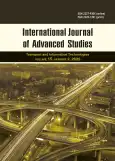Traffic congestion forecasting using machine learning methods
- Authors: Zagidullin R.R.1, Khaybullin A.N.1
-
Affiliations:
- Kazan (Volga region) Federal University
- Issue: Vol 15, No 2 (2025)
- Pages: 202-216
- Section: Articles
- Published: 30.06.2025
- URL: https://journal-vniispk.ru/2328-1391/article/view/299344
- DOI: https://doi.org/10.12731/2227-930X-2025-15-2-347
- EDN: https://elibrary.ru/HHJBXM
- ID: 299344
Cite item
Full Text
Abstract
Background. This study develops a comprehensive approach to traffic congestion forecasting using synthetic data that simulates the dynamics of urban traffic. A hybrid methodology is proposed that combines time series analysis and deep learning, which is highly relevant for modeling nonlinear dependencies and patterns in traffic data.
Purpose. The purpose of this study is to develop and test a predictive model capable of accurately forecasting traffic congestion levels while accounting for seasonal and weather-related factors.
Materials and methods. To identify patterns in the data, additive time series decomposition, spectral analysis based on the fast Fourier transform, and autocorrelation analysis were applied. The predictive model was implemented using a two-stage approach: the classical ARIMA algorithm was used for baseline forecasting, while an LSTM architecture with two recurrent layers and regularization was trained on 24-hour sequences. Additionally, to compare and validate the results, the ensemble method Random Forest was used, configured with the following hyperparameters: 200 trees, maximum depth of 12, minimum samples per leaf of 2.
Results. The results demonstrate the superiority of the LSTM model over ARIMA and Random Forest in terms of predictive accuracy, as confirmed by visual comparison of forecasts with test data and by the mean squared error metric. Key factors influencing congestion were identified, including daily traffic intensity cycles, increased load during precipitation events (up to 30% during snow and 20% during rain), as well as temperature-dependent modulation of traffic flow.
Keywords
About the authors
Ramil R. Zagidullin
Kazan (Volga region) Federal University
Author for correspondence.
Email: Ramil.Zagidullin@kpfu.ru
ORCID iD: 0000-0001-5185-2690
Scopus Author ID: 57193743308
ResearcherId: E-5671-2018
Candidate of Technical Sciences, Associate Professor of the Department of Structural and Design Engineering, Institute of Design and Spatial Arts
Russian Federation, 18, Kremlevskaya Str., Kazan, 420008, Russian FederationAlmaz N. Khaybullin
Kazan (Volga region) Federal University
Email: almaz.khaybullin@mail.ru
ORCID iD: 0009-0001-7321-956X
Scopus Author ID: 5830790020
ResearcherId: LMP-8981-2024
Technician at the "Intelligent Mobility" Research Laboratory (R&D Lab), Institute of Design and Spatial Arts
Russian Federation, 18, Kremlevskaya Str., Kazan, 420008, Russian FederationReferences
- Khamidulin, T. G. (2019). Application of artificial neural networks in the transport industry. Economics and Society, (4), 851–858. EDN: https://elibrary.ru/ZZRFOP
- Galushkin, A. I. (2015). Neural networks: Fundamentals of theory. Moscow: RIS. 496 p.
- Red'ko, V. G. (2019). Evolution, neural networks, intelligence: Models and concepts of evolutionary cybernetics. Moscow: Lenand. 224 p.
- Bochkarev, A. A., & Bochkarev, P. A. (2024). Urban transport logistics systems: A textbook for universities (3rd ed., revised and supplemented). Moscow: Yurayt. 162 p. EDN: https://elibrary.ru/BVRIOQ
- Gerami, V. D., & Kolik, A. V. (2024). Transport systems management. Transport logistics support: A textbook and practical guide for universities (3rd ed., revised and supplemented). Moscow: Yurayt. 536 p. EDN: https://elibrary.ru/BCZLEH
- Andreeva, L. A., et al. (2015). Innovative processes of logistics management in intelligent transport systems (under the editorship of Mirotin, L. B., & Levin, B. A.). Volume 2. Formation of industry-specific intelligent transport logistics systems. Moscow: Educational and Methodological Center for Education in Railway Transport. 343 p.
- Dushkin, R. V. (2020). Intelligent transport systems: Traffic modeling and forecasting. Transport Systems and Technologies, (4), 45–62.
- Boukerche, A., & Wang, J. (2020). Machine learning-based traffic prediction models for intelligent transportation systems. Computer Networks, 181, 107530. https://doi.org/10.1016/j.comnet.2020.107530 EDN: https://elibrary.ru/HKZXAK
- Nikolaenko, S. I., Kadurin, A., & Arkhangelskaya, E. V. (2018). Deep learning: Diving into the world of neural networks. Saint Petersburg: Piter. 480 p.
- Flach, P. (2015). Machine learning: The science and art of building algorithms that extract knowledge from data. Moscow: DMK Press. 400 p.
- Burkov, A. (2020). Machine learning without unnecessary words. Moscow: Alpina Publisher. 100 p.
- Faustova, K. I. (2017). Neural networks: Current applications and future development prospects. Territory of Science, (4), 83–87. EDN: https://elibrary.ru/ZXPNRL
- Ivanko, A. F., Ivanko, M. A., & Sizova, Yu. A. (2019). Neural networks: General technological characteristics. Scientific Review. Engineering Sciences, (2), 17–23. EDN: https://elibrary.ru/QHUGLR
- Haykin, S. (2006). Neural networks: A comprehensive foundation (2nd ed.). Moscow: Williams. 1104 p.
- Ezhov, A. A., & Shumsky, S. A. (1998). Neurocomputing and its applications in economics and business. Moscow: MEPhI. 268 p.
- Tarkhov, D. A. (2005). Neural networks. Models and algorithms. Moscow: Radiotekhnika.
- Hastie, T., Tibshirani, R., & Friedman, J. (2009). The Elements of Statistical Learning: Data Mining, Inference, and Prediction (2nd ed.). New York: Springer-Verlag.
Supplementary files










